#bouleuterion
Explore tagged Tumblr posts
Text

Today's Flickr photo with the most hits - the bouleuterion of Miletus. in present day Turkiye. The bouleuterion was the seat of the city assembly / council.
0 notes
Text


Painted Scylla Statues Found in Turkey
Excavations in ancient Laodicea have revealed a rare collection of painted Scylla statues.
Laodicea was an Ancient Greek city on the river Lycus, located in the present-day Denizli Province, Turkey.
The city was founded between 261-253 BC by Antiochus II Theos, king of the Seleucid Empire, in honour of his wife Laodice. Over the next century, Laodicea emerged as a major trading centre and was one of the most important commercial cities of Asia Minor.
After the Battle of Magnesia during the Roman–Seleucid War (192–188 BC), control of large parts of western Asia Minor, including Laodicea, was transferred to the Kingdom of Pergamon. However, the entire Kingdom of Pergamon would eventually be annexed by the expanding Roman Republic in 129 BC.



The many surviving buildings of Laodicea include the stadium, bathhouses, temples, a gymnasium, two theatres, and the bouleuterion (Senate House).
Recent excavations led by Prof. Dr. Celal Şimşek from Pamukkale University have revealed a rare collection of painted Scylla statues during restoration works of the stage building in the Western Theatre.
In Greek mythology, Scylla is a man-eating monster who lives on one side of a narrow strait, opposite her counterpart, the sea-swallowing monster Charybdis. The two sides of the strait are so close (within an arrow’s range), that sailors trying to avoid Charybdis’s whirlpools would dangerously come into range of Scylla.
Scylla is first mentioned in Homer’s Odyssey, where Odysseus and his crew encounter both Scylla and Charybdis during their voyage back to Ithica following the conclusion of the Trojan War.


In a press statement by Nuri Ersoy, Minister of Culture and Tourism: “These extraordinary sculptures are quite important in terms of being rare works that reflect the baroque style of the Hellenistic Period and have survived to the present day with their original paints.”
The archaeologists suggest that the sculptures were made by sculptors in Rhodes during the early 2nd century BC and are the oldest known examples from antiquity.



#Painted Scylla Statues Found in Turkey#ancient Laodicea#ancient greek city#sculptures#ancient sculptures#ancient artifacts#archeology#archeolgst#history#history news#ancient history#ancient culture#ancient civilizations#greek history#roman history#roman empire#greek art#ancient art#art history
212 notes
·
View notes
Photo

Glanum
Glanum, located near St-Rémy-de-Provence in southern France, was a Greek and then Roman town which prospered due to its location on trading routes between Italy and the Rhodanus (Rhone River). The town benefitted from a large building project in the Hellenistic period and another spree during the reign of Augustus which furnished Glanum with temples, a theatre, basilica, monumental arch, and Roman baths, amongst other amenities. The town was abandoned in the 3rd century CE but today offers the modern visitor an impressive array of Greco-Roman ruins.
Historical Overview
Glanum was first settled by the Celts, specifically the Salyans (Salluvii), from the 7th to 6th century BCE. Indeed, the town's name derives from Glan, a Celtic spring deity who continued to be worshipped at the site into the Roman period. The town grew following an influx of colonists from Massalia (Marseilles) in the 2nd century BCE. Flourishing as a trade centre and noted as a place of healing, Glanum began to mint its own silver coinage (with a bull and a Glanic mother goddess design) and benefitted from a Hellenistic building programme which included a peristyle building, ornamental spring, temple, bouleuterion (public assembly theatre), and several large private villas. The town spread to cover some 20 ha in this period and was protected by a circuit wall.
The Romans took an interest in the town from the 1st century BCE following the Second Salyan War (90 BCE) when the consul Caecilius quashed what would be the last Celtic revolt in the region. The town was razed, but during the reign of Augustus, Glanum once more benefitted from a programme of rebuilding. New monumental structures included an agora, forum, theatre, a curia (council building), basilica and various other public buildings, temples, Roman baths, a triumphal arch, and mausoleum. Outside the town, two aqueducts were built to regulate Glanum's water supply. In addition to new buildings, the town was granted certain Latin privileges, made a full Roman colony in the 1st century CE, and continued to prosper as a trading stop near the Via Domitia.
Glanum's glory days came to an end when it was destroyed by the Alemanni c. 260 CE. The site was then abandoned by the local people in favour of a new location at nearby St-Rémy-de-Provence. Glanum was first excavated in the early 20th century CE and work continues today with some of the temples undergoing restoration.
Continue reading...
27 notes
·
View notes
Text
Ephesus
Today was the visit to the leading ancient site of the cruise, Ephesus.
Ephesus was a Greek and Roman city founded in the 10th century B.C. on an earlier Arzawan settlement site. It was one of the region's principal cities based on its port, location on a river providing access to the interior, and sanctuary to Artemis.
We first stopped at the local museum, which contained sculptures and artifacts from the site. Some of these, like the Minoan pottery, attest to the early occupation.

Ephesus also developed coins early, using the local electrum ore. The first coins had images of a bee.

Most of the statuary was Roman. Only a few Greek statues remain for two reasons: their age and the fact that most Greek statues were bronze, which was melted down and reused, both for decorative items and weapons.

However, the most significant statues were of Artemis. Greek Artemis was the equivalent of Roman Diana, the goddess of the hunt, the wilderness, wild animals, nature, vegetation, childbirth, child care, and chastity. The local version was equated to the earlier Great Mother Goddess and portrayed quite differently than the Roman version. A chart on the wall showed the development of the Great Mother Goddess images over time.

In Ephesus, she was portrayed in a a very dramatic manner.

There is a lot to unpack here. Starting at the top, she wears a crown with the city on top. She has wild animals on either side of her head.


She has a lion on each arm; the most noticeable thing is all those protuberances. There has been much debate over what they represent. Breasts reflecting the abundance of the Great Mother? Stories say she was often hung with bull's testicles, and there is undoubtedly a resemblance there. Other sources indicate her statues could be hung with gift bags. We don't know, but it is undoubtedly a memorable image.
Her skirt is covered with the wild animals she was also a protector of.

There was also a slightly smaller statue. Here, you can see the two hunting dogs accompanying her as the goddess of the hunt.

In antiquity, the Temple of Artemis was one of the Wonders of the Ancient World. The last and greatest version was built starting in 356 B.C. It stood for 600 years until it was destroyed by the Goths in 268 AD. With the coming of Christianity it was finally abandoned.
The stones were, of course, recycled into other buildings. Today almost nothing remains.

The one lone, sad column was haphazardly re-erected in modern times from odd bits left around the site.
There was a model in the local museum.

Antipiter of Sidon described the temple thus in his Seven Wonders:
"I have set eyes on the wall of lofty Babylon on which is a road for chariots, and the statue of Zeus by the Alpheus, and the hanging gardens, and the colossus of the Sun, and the huge labor of the high pyramids, and the vast tomb of Mausolus; but when I saw the house of Artemis that mounted to the clouds, those other marvels lost their brilliancy, and I said, "Lo, apart from Olympus, the Sun never looked on aught so grand".
Alas, all we saw was a barren field and a poor column.
Then, it was on to the city itself. The most impressive part of the city was its marble-paved streets.


A gate on the street, consisting of two statues of Hercules, narrows the passage, apparently to stop the use of carriages.

What at first looks like a theater is a bouleuterion, or city council chamber.

It is so much larger than any others we've seen we al thought it was a small theater.
The most famous structure in Ephesus is the library.

It's a beautiful and impressive building front, but it is all restored. Before the restoration, only the column bases and lower parts of some columns were standing. The restorations Türkiye does are controversial. Some archeologists believe that everything should be left as found. Some people want to rebuild. I think that some restoration is beneficial for people to understand the ancient sites. Of course, they need to be done accurately and respectfully. Also, not all sites or structures should receive this treatment. It's costly and does some damage to the materials. But I certainly agree with the restoration of the Library in Ephesus.
Throughout this entire area, archeologists from various European countries did excavations. They also took may of the best artifacts and buildings back home. So museums in London, Berlin, and Paris have the absolute best of these ancient cities.
Completing our visit was the road down to the agora, theater and harbor.




One area I had not heard about was the "Terrace Houses." These are a series of huge Roman houses on the hill above the main street. They are decorated with marble paneling, frescoes on the walls, and mosaics and marble on the floors. Even the second floors of the houses had frescoes and mosaics. The one even had private bach and toilet.







Cleary Ephesus was an influential and wealthy city with some very wealthy residents.
14 notes
·
View notes
Text

The bouleuterion (assembling hall) and triporticus at Teos (Türkiye). One mosaic there shows dates to the third century B.C.E. and depicts a pair of winged cupids. The other mosaci shows two griffins!
3 notes
·
View notes
Text





Paestum, Salerno
Paestum è una località di vasto interesse archeologico situata in Campania esattamente in provincia di Salerno è costituisce una frazione del comune di Capaccio Paestum, a circa 30 chilometri a sud di Salerno. Il nome latino corrisponde a Paistom, così come fu denominata dai Lucani che la conquistarono.
I fondatori la chiamarono Poseidonia in onore del dio del mare: Paestum e i suoi templi sono oggi patrimonio dell’UNESCO e Paestum rappresenta il sito archeologico meglio conservato ai nostri giorni. Sorge sulla piana del Sele proprio sul golfo di Salerno: la piana, aspra e selvaggia, è un esempio perfetto di archeologia di rara bellezza. La cinta muraria è ancora perfettamente conservata e così anche le quattro porte della città: le frazioni principali sono rappresentate dal Foro e dai Templi; il grado di conservazione di questi maestosi monumenti è davvero apprezzabile soprattutto per quanto riguarda i templi dorici dedicati a Hera e Athena. Esternamente alle mura sorgono numerose necropoli e tombe affrescate, con un museo ricco di oggetti e arredi provenienti dalle necropoli. Da non perdere la Tomba del Tuffatore, una delle più belle di Paestum. Altre attrazioni importanti da segnalare sono l’Agorà, la piscina, l’Anfiteatro, il tempio italico e il Bouleuterion greco.
2 notes
·
View notes
Text
Holy Sanctimony!
The sea is a wild thing. It can be calm one moment and violent the next. While the Aegean seemed an almost docile creature in Kusadasi, by the time we arrived at Canakkale, it was whipping at us with gale-force winds with white-tipped waves crashing against the shore. It was as if we had angered the God of the Sea, Poseidon, himself.


Our adventures in Turkiye, on the seventh of March, ranged from a quiet respectful introspection to the loud and boisterous. The first stop for the day was the House of the Virgin Mary, where it was believed she retreated to after the death of her son, Jesus. Though there sin’t any conclusive proof that the hideaway in the Turkish mountains is anything beyond a humble dwelling, it is still treated with much reverence by the staff there. Pastors, too, are even allowed to preach just beside it as well.
From there, we headed to the ancient of Ephesus. Initially built during the Hellenistic period, the site had also been adapted by the Romans when they took control of the region. Of particular note, again, were the baths, the tabernae that lined the main street, the gymnasium, the bouleuterion (which housed the meetings of the council and also doubled as a place for musical performances) as well as a temple dedicated to Domitian, the last emperor of the Flavian dynasty that followed after Nero’s disastrous reign.
Reading through the information boards, mostly after the fact (because I took pictures of them), I was tickled pink to learn that after the city was bequeathed to the Romans in 131BC, Marc Antony and Cleopatra spent a winter in the city to prepare for their campaign against Rome’s very first Emperor, Octavian (better known as Augustus). And as we students of history all know, the Battle of Actium didn’t quite go in the favour of our beloved star-crossed lovers.
During this period of Greek and Roman rule, Ephesus served as a major port on the Aegean Sea. Although the sea has apparently receded in more recent millennia, it was still fun to watch our tour guide re-enact how an old-timey merchant might have spent his time onshore after pulling into the harbour. I certainly ought to keep such city-building and planning in mind when creating my fantasy cities.


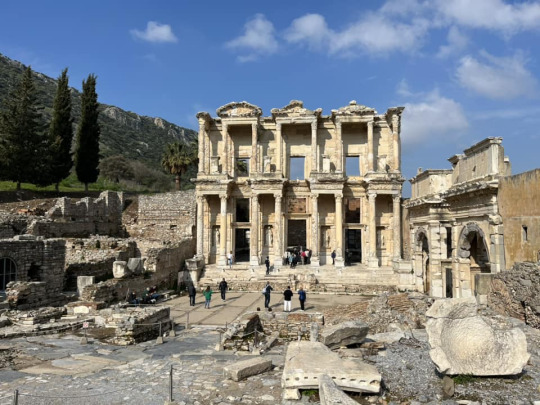
Ephesus also played host to possible pleasure houses opposite the impressive remains of the Library of Celsus. According to the information board, which I did not take a photo of (silly me), the ‘pleasure houses’ were terraced houses that contained certain objects that made archaeologists suspect that it was being used for more than just a roof over a resident’s head.
Since, of course, no time machine exists, we simply must make our best educated guess about the civilisations of the past. But for all we know, the ruins that we saw at Ephesus might just have been innocent terrace houses and we ought to stop suspecting the people of the past of committing such salacious deeds. Prostitution might be the oldest profession but well, it’s still up in the air whether this was the case at Ephesus.
Oh, and I forgot to mention that near the surrounds of Ephesus, there was a Temple dedicated to Artemis that was considered one of the Ancient Wonders of the World. As we drove to Ephesus, proper, there were columns along the side of the road that would have indicated the temple’s approximate location. Unfortunately, as explained in a previous post, a lot of the original material that was moved to Constantinople and used in the construction of the Hagia Sophia.
Talk about recycling!
Even with the advent of Christianity in the region, the city of Ephesus stood strong though there were a few changes, including the construction of churches and dedications to Jesus and his mother, Mary.
And while we did see a significant portion of the old city, around 80% of the city is still buried underground. Some can be seen poking through the surface but other remains are buried 8 metres under!
From Ephesus, we headed to a questionable cafeteria that employed a lot of oil in their food before we arrived in the small village of Sirence. Now, the significance of this little town was that it used to harbour a lot of Greeks in the area. As such, it was known for its wine and olive oil. As I walked down the streets, I cooed at crocheted dolls and was very tempted to purchase a number of cute adorable animal creations. In the end, however, I settled for getting a new leather wallet to replace my old Mickey Mouse one that I bought in America back in 2004.
From Sirence, we drove to Canakkale and checked into the Halic Park Hotel. Tomorrow is Troy and my body is ready to regale you all with the cliff notes version of the Iliad. And, of course, tell you about the most infamous horse of all time!
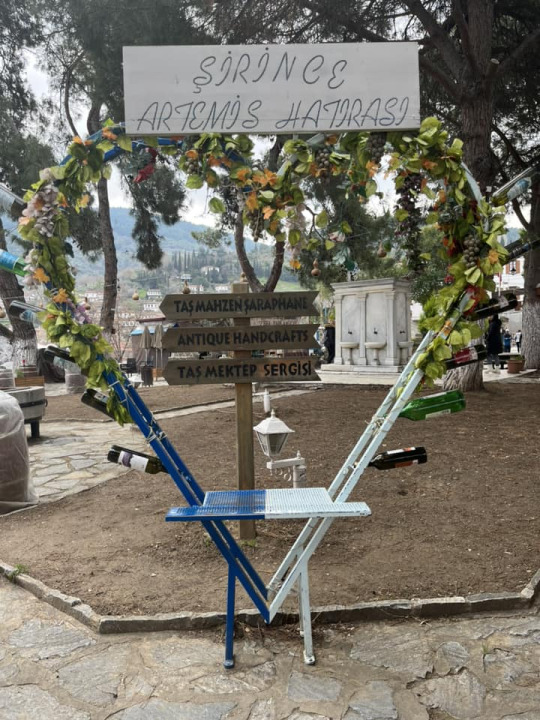


5 notes
·
View notes
Text
Archaeologists Discover Mosaics of Two Fighting Cupids and a Mysterious Inscription at an Ancient Greek City Hall | Smithsonian
0 notes
Text
Día 15, Segunda parte: ruinas de Patara y ocaso en la playa
La culminación del plan maestro: a las 18:30 en Patata para ver las ruinas con la caída del sol.
Primera parte, insuperable. Hemos podido pasear sin que nos sudase el bigotillo (apenas).
Aquí también hay portadas monumentales.

Y teatro (el espectáculo lo han puesto las cabras que ocupaban el escenario y andaban haciendo ensayo de luchas casamenteras.

La calle porticada que llevaba al puerto.

El edificio del consejo ciudadano (el bouleuterion) bastante reconstruido.

Después de pasear a voluntad por todo el recinto hemos decidido que era momento de recorrer los 300 metros que nos separaban de la playa y darme un chapuzón y ver el sol ponerse.




Para volver a casa, hacernos una tortillita y una ensalada y dar el día por terminado.

Y por fin nos hemos puesto al día!
Mañana vamos a volver a bañarnos a Patara, pero esta vez a las 8 de la mañana. Luego visitaremos ruinas y nos pasaremos la tarde en la piscina del apartamento.
0 notes
Photo

Glanum
Glanum, located near St-Rémy-de-Provence in southern France, was a Greek and then Roman town which prospered due to its location on trading routes between Italy and the Rhodanus (Rhone River). The town benefitted from a large building project in the Hellenistic period and another spree during the reign of Augustus which furnished Glanum with temples, a theatre, basilica, monumental arch, and Roman baths, amongst other amenities. The town was abandoned in the 3rd century CE but today offers the modern visitor an impressive array of Greco-Roman ruins.
Historical Overview
Glanum was first settled by the Celts, specifically the Salyans (Salluvii), from the 7th to 6th century BCE. Indeed, the town's name derives from Glan, a Celtic spring deity who continued to be worshipped at the site into the Roman period. The town grew following an influx of colonists from Massalia (Marseilles) in the 2nd century BCE. Flourishing as a trade centre and noted as a place of healing, Glanum began to mint its own silver coinage (with a bull and a Glanic mother goddess design) and benefitted from a Hellenistic building programme which included a peristyle building, ornamental spring, temple, bouleuterion (public assembly theatre), and several large private villas. The town spread to cover some 20 ha in this period and was protected by a circuit wall.
The Romans took an interest in the town from the 1st century BCE following the Second Salyan War (90 BCE) when the consul Caecilius quashed what would be the last Celtic revolt in the region. The town was razed, but during the reign of Augustus, Glanum once more benefitted from a programme of rebuilding. New monumental structures included an agora, forum, theatre, a curia (council building), basilica and various other public buildings, temples, Roman baths, a triumphal arch, and mausoleum. Outside the town, two aqueducts were built to regulate Glanum's water supply. In addition to new buildings, the town was granted certain Latin privileges, made a full Roman colony in the 1st century CE, and continued to prosper as a trading stop near the Via Domitia.
Glanum's glory days came to an end when it was destroyed by the Alemanni c. 260 CE. The site was then abandoned by the local people in favour of a new location at nearby St-Rémy-de-Provence. Glanum was first excavated in the early 20th century CE and work continues today with some of the temples undergoing restoration.
Continue reading...
40 notes
·
View notes
Text
Priene
Today, we started heading back south. The boat sailed south out of Kuşadasi while some of us headed inland to ancient Priene.
Kuşadasi is a major tourist location. While we were there, four cruise ships and many private boats were in the harbor. Docked next to us was a private yacht owned by a Khazak mining magnate.
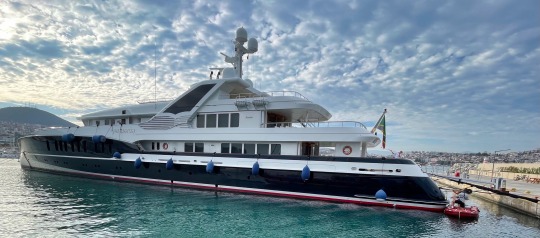
It cost $65 million, has a crew of 19, and spends most of its time in this dock. We watched the crew scrub down the stern as we prepared to leave.
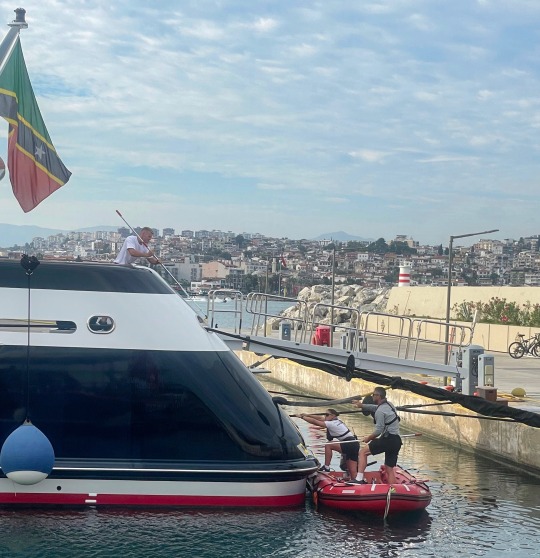
It's for sale if you are interested.
Then, it was into a van for the drive to Priene.
Priene was another Greek/Roman town but on the side of a hill. It was an early experiment for the Greeks in geometric town planning. It was all laid out on a regular grid, with defined commercial, municipal, and residential zones. This was not new in the ancient world; it had been standard in Mesopotamia for eons, but the Greeks lived in hilly areas and typically built around the terrain.

As usual, we stopped in shady places throughout the site for short discussions on various facets of the town.
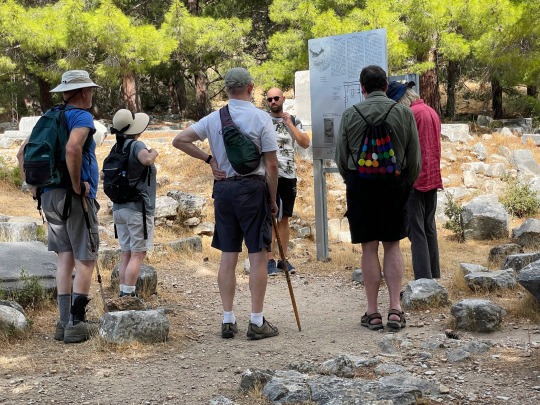
Our first stop was the theater.

The premium seating in the first row was well preserved.

The stage was also well preserved. It was on top of the columns in the background.
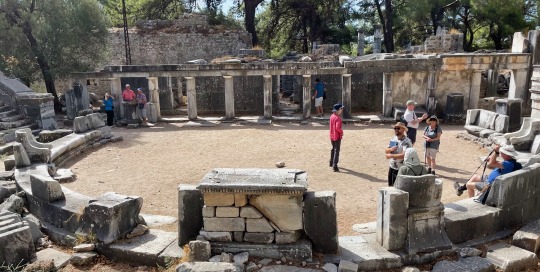
There was a small Christian church in a basilica format.

In the center was a stair that would have served a platform for giving the sermon.

Then, it was to the Temple of Athena.

Amazingly, those columns are not re-erected but still stand from ancient times.
Then down to the Agora.

The bouleuterion also follows the rectilinear model of the town, quite different from the standard semi-circular shape.

Then back down the hill and back to the boat.

We had a long cruise south to get close to Bordum. It was very windy and relatively rough. The chairs on the deck were sliding all over; we could hear crashes from the galley and learned afterward that plates and such broke. As a landlubber, I am not a good sailor, but with a couple of patches behind my ears, I stayed on the deck where I could see the horizon and have the fresh breeze. I had no problems.
3 notes
·
View notes
Photo







Bouleuterion / Odeon
Aphrodisias, Asia minor (Turkey)
2nd century CE
The Council House or Bouleuterion was completely rebuilt in the second century CE as a small, marble-lined covered theatre. This marked the Council as a prized political institution. It was the chief body of democratic city government but was controlled by a relatively few wealthy families who were close to Rome and the imperial government and made the domination of civic politics their business. Control of the Council was marked by the family that paid for it: their members received prominent statue honours set up inside and outside of the building. This is the period of the densest statue production and the use of portrait statues as active political symbols. The Council House preserves one of the best examples of the dynamic statue life of a major civic complex.
The Council House/Bouleuterion was the centre of political power in the city. It was here that the boule (city council) met, composed of the wealthiest citizens and dominated by a few of the most powerful families. The present Council House was an elaborate new structure built in the later second century by the family of Tiberius Claudius Attalos, a Roman senator, and his brother Diogenes. Its rich marble architecture marked the importance of the Council as an institution and the position of this family within it: their statues dominated both the interior and the exterior.
The building was connected directly with the North Agora in an urban ensemble common in Asia Minor (found also, for example, at Ephesos). It was a covered, theatre-like structure, lined with marble seating for a maximum of about 1,700 persons, with a two-storey columnar marble stage-façade. This façade faced the auditorium and carried statues of important civic benefactors between its columns.
The seating was supported by a series of radial barrel vaults. The lower part of the seating (nine rows) survives in excellent condition; of the upper part (a further twelve rows) only the walls for the supporting vaults remain. The Council House was large enough to serve, as a modern town hall does, for a variety of other purposes and entertainments (music and performance oratory, for example), as well as for meetings of the Council. The building remained in use into late antiquity when its interior was lightly re-modelled by the removal of two rows of seats and the creation of sunken orchestra. The form of this re-modelling is referred to as a palaistra in a prominent fifth-century inscription on the upper moulding of the stage.
Sources: 1, 2
#Bouleuterion#Odeon#roman#roman art#roman architecture#travel#history#asia minor#turkey#Aphrodisias#2 ce#Council House
140 notes
·
View notes
Text
Thersilion
371 BC, Megalopolis (GR)
via #1, #2, #3, #4




95 notes
·
View notes
Photo

🇬🇧 Ekklesiasterion Ekklesiasterion (ἐκκλησιαστήριον; ekklēsiastḗrion). Meeting-place of a Greek public assembly. Among the cities where the word ekklesiasterion is used are Olbia and Delos during the period of the Athenian klerouchoi in the 2nd cent. BC.
🇹🇷 Ekklesiasterion Ekklesia isimli Yunan meclisinin toplantılarını yaptığı, basit bir bouleuterion olarak nitelendirilebilecek yapı.
#archaeologs#archaeology#archaeological#dictionary#history#ancient history#ancient greece#ekklesiasterion#bouleuterion#arkeoloji#tarih#antik yunan
6 notes
·
View notes


